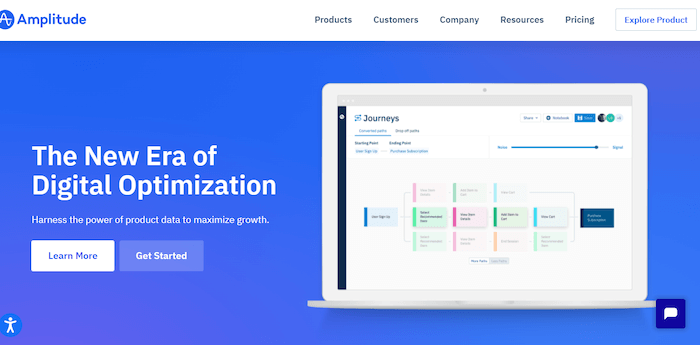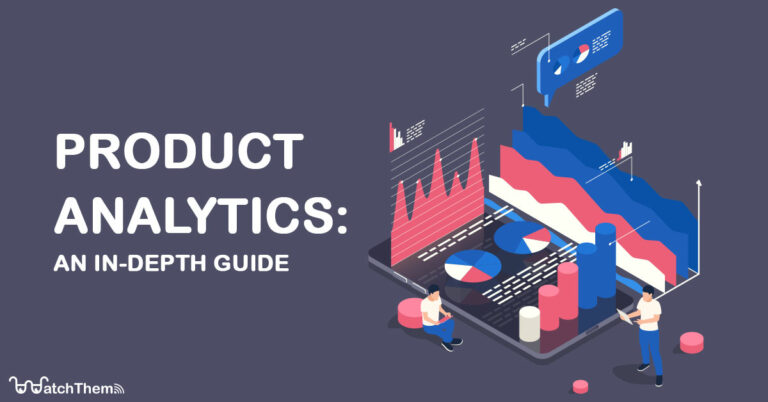Page Contents
Product analytics give you a complete insight into how your customers interact with your product. Generally, It’s all about how your customers engage with your product. It helps you understand how your customer is using your product, what problems and questions they have, and what they like and dislike about your product. It lets you track, visualize and analyze any behaviors your customers have, who they are, which helps you map your customer journey.
To understand how customers engage with your product, WatchThemLive is an excellent tool. Sign up for FREE and see what’s next!


What Is Product Analytics?
Product analytics is a powerful tool that gives you and your team deep and valuable information about your product and user interaction. This will help you resolve any problem your customers have with your product, make room for improvement, and guarantee customer loyalty to increase conversions.


Why Is There So Much Emphasis on Product Analytics?
Some eCommerce store owners might think that selling their product is all there is to marketing. That’s not it! 65% percent of customers are the ones who have already purchased something from you. therefore, after they buy a product from your store, you have to answer their questions and turn them into regular buyers.
Giving value to your customers will benefit you as well. After analyzing customers’ interactions with your product, you have solid information based on experiments to optimize conversion rate and improve your outcome.
What Is Product Management Analytics?
Product management analytics tools help your collect product data to improve your products and make better ones. Product management analytics tools also track users’ actions and provide that information to different teams to make room for growth. Using this information about users, you can make the right decisions, increasing retention and conversion rate. however, product analytics management only gives you information about your product; it can’t make changes; rather, it guides the decision-making.
Product Analytics Metrics
Product analytics are essential for measuring the metrics that most influence your business. Selecting the right metrics is an important part of your job. There are different kinds of product metrics that you should put into consideration while analyzing your product. Here we introduce 4 types of these metrics:
1. Engagement Metrics
Your customer goes through different stages until they buy your product. By visualizing the user journey from the start, you can understand how your users go from just viewing your homepage to signing up and purchasing.
Product analytics can help you realize how customers interact with your product, what they like, what disturbs them, what questions they have, and for what purpose they’re using your product. Therefore, it creates the chance for more improvement.
Here are some of the product management engagement metrics:
- Time on site or app
- Viewed pages
- Shopping cart abandonment
- Average active daily users (ADAU)
Understanding your customer’s behavior plays an important part in increasing your website conversion rate. Looking for a tool to track customer interactions with your website? Sign up to WatchThemLive and get started.


2. Cohort Analysis Metrics
Cohort analysis lets you divide your customers by their actions. like which customers are purchasing or which need a push, when did they visit your homepage for the first time, or when did they talk to your customer support. Cohorts also can be divided based on other factors. For example, a new cohort that uses your completed product may have a better experience than a cohort that used your product in the early stages of launching.
Here are the metrics you need to track when performing cohort analysis:
- Completion of goals
- Transaction per user
- Pageviews
3. Retention Metrics
By doing retention analysis, you will understand how many of your customers are returning to your product in different periods of time. Did they return to your product on day one or one week later? Unlike a cohort analysis, a retention analysis normalizes cohorts during the initial period and presents the aggregate retention rate for subsequent periods.
Depending on the use case, the cohort units may differ. Days, weeks, months, and even quarters are all possibilities.
A specific cohort and a repeat action are required for every retention analysis, just as they are for cohort analysis.
Here are some of the product management retention metrics:
- Churn rate
- Customer loyalty
4. Funnel Metrics
You can find new potential for improvement and growth if you can view and measure how your users go through a sequence of processes. Usually, conversions can be improved by analyzing funnels. You may discover that users abandon your onboarding process or their shopping carts without completing checkout.
Here are some of the most important funnel metrics:
- CPA
- LTV
- Conversion rate
Who Uses Product Analytics?
Anyone who wants to make better choices about their product should use product analytics. Because the data is behavior-based and you are collecting 100% of the user activity from your website, analytics can provide answers to stakeholders’ questions throughout your organization. Once you have all of the necessary information, you can answer all the questions.
Now, let’s see who can benefit from product analysis:


UX Designers
UX designers may study how users use product features in detail, evaluate which are the most popular and which are the most perplexing, and find obstacles and key points of abandonment.
Product Team
Usually, product managers are at the top of the list. Data from product analytics reveals a great deal about user behavior. Moreover, Customer behavior should guide product decisions, and analytics is a great way to find that information.
Marketing Team
Even if you’re not marketing a product, product analytics tools can provide you with useful information. Marketers can see which channel, such as social media, emails, etc., is bringing them the most visitors. They can also see which marketing campaign is bringing them more conversions. With this information, marketers understand where they should put their attention to.
There are also some other people who can benefit from using product analytics, such as engineers, CEOs, data scientists, etc.
How to Put Product Analytics to Work?
Product Analytics might be simple to implement. To collect actionable data, companies must first define a general framework. Generally, as part of the development and deployment process, the data collection procedure is streamlined by following a well-defined framework.
Through data collection, you should find the answer to these questions:
- What exactly do users do?
- How can I track user actions?
- When should user activities be collected?


What Exactly Do Users Do?
User actions include three parts:
1. Name Of the Action
This is the name of the action being performed by the user. View tab, invite user, submit an application are some examples.
2. Properties Of the Action
Every action will have a unique set of properties. For example, the invite user tab has properties like name and URL.
3. Timestamp Of the Action
This is the time this activity took place, which is often in Unix timestamp format.
This way, developers will no longer have to waste time guessing the right action name and properties for every new interaction or feature they release.
Best Product Management Tools
To gather all the data you need to analyze, Firstly, you need a product management tool. Here are some of them:
1. WatchThemLive


Tracking your customer’s behavior is an important part of product analytics. WatchThemLive does this for you by providing heatmaps and session recording. Heatmaps are the best option to visualize how customers interact with your web pages, and session recordings give you a real-time recording of users interacting with your web pages.
If you are looking for a tool to do this for you, WatchThemLive is the best option. Sign up and get started.
2. Google Analytics


Google Analytics is one of the first analytics tools out there. The good thing is that If you’re in the early process of your business, you don’t have to pay for it. Analytics integrates with Google’s advertising and publishing tools, allowing you to put your data to work for your company.
3. Amplitude Analytics


Amplitude Analytics has some powerful features, such as real-time analytics and cross-platform tracking. It also has a strong supporting system and security team. It intelligently adjusts and tailors each individual experience with knowledge of which behaviors led to which consequences. So, it delivers the right experience to the right individual at the right moment.
Conclusion
In this article, we talked about product analytics and its importance. Then, we talked about customer product management analytics and different types of product analytics metrics. We discussed who might use product analytics, how to put it to work, and the best tools you can use.
The most important thing in customer analytics is first to track your customers’ behavior.
If you are looking for the best tools for this means you can sign up to WatchThemLive and get started.
Hope this was useful!


